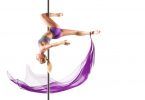Choreography is the heart and soul of pole dancing, merging technique, artistry, and movement into a cohesive, expressive form. For pole dancers, mastering choreography is about understanding the intricacies of movement, how to use transitions effectively, and connecting the mind with the body to convey emotion through dance. Whether you’re a beginner or an experienced pole dancer, developing a solid foundation in choreography can elevate your performances, bring out your unique style, and improve your technique. Let’s explore essential tips and strategies for mastering choreography and crafting dynamic pole routines that resonate with audiences and fulfill personal creative goals.
Introduction to Mastering Choreography for Pole Dancing
Choreography is what brings personality and creativity to pole dancing, bridging athletic movement with artistic expression. When pole dancers focus on mastering choreography, they gain the ability to tell a story, showcase unique skills, and captivate audiences. Unlike routines that rely solely on technical prowess, choreography weaves together skills, transitions, and expressions to create a cohesive piece that flows seamlessly. It’s the difference between performing a series of impressive tricks and delivering a memorable, emotionally compelling experience. For dancers who are eager to bring new depth and dimension to their pole routines, learning to master choreography is both an exciting challenge and a rewarding pursuit.
Benefits of Mastering Choreography in Pole Dancing
Mastering choreography has multiple advantages for pole dancers. For one, it enhances overall performance quality by creating a smooth transition between pole tricks, spins, and floor moves. Additionally, choreography helps dancers explore their creativity, giving them the tools to convey personal stories, moods, or themes through their routines. Through thoughtful choreography, dancers can create a more polished and professional presentation, whether for competitions, performances, or personal growth.
Some of the key benefits include:
- Enhanced Flow: Seamless transitions create a captivating flow that keeps the audience engaged.
- Improved Creativity: Choreography allows dancers to experiment with unique movements and styles.
- Stronger Physical and Mental Coordination: Planning and executing a routine enhances both physical technique and mental focus.
- Expression and Emotional Depth: Choreography enables dancers to convey emotions, making routines more impactful.
The Foundation of Pole Choreography: Basics and Beyond
To master choreography, it’s essential to start with the basics. This includes understanding foundational movements, transitions, and positions on and around the pole. For beginners, building a library of core movements will make choreographing routines easier and more versatile. Common foundational moves include spins, climbs, holds, and floor work that dancers can use as building blocks in their routines.
For experienced dancers, expanding beyond the basics with advanced moves, intricate transitions, and floor work can enrich the routine. However, remembering that choreography is about the flow rather than cramming in as many moves as possible is crucial for creating polished performances.
Essential Elements of Pole Dance Choreography
To create compelling choreography, it’s helpful to incorporate a variety of elements that add texture and dimension to the performance. These include:
- Transitions: Smooth, well-thought-out transitions between moves that connect different sections of the routine.
- Levels and Dynamics: Using floor work, mid-pole, and high-pole moves to add depth.
- Timing: Coordinating movements with music for added dramatic effect.
- Direction and Spatial Awareness: Moving around the pole and utilizing different angles for visual interest.
By combining these elements, dancers can create routines that are both technically challenging and visually dynamic.
Creating Flow Between Moves
Flow is what makes choreography captivating. Rather than moving from one trick to another abruptly, a well-choreographed pole dance routine flows seamlessly from move to move. This flow can be achieved through transitions that are well-practiced and connect movements in a way that feels natural. Utilizing spins, body rolls, and leg transitions can help establish flow while adding variety. Moreover, using breath-to-time movements also helps maintain a consistent rhythm, adding a professional touch. Practicing choreography safely is essential for building confidence. High-quality pole dancing safety mats provide secure cushioning for practicing new moves and transitions, letting you focus on perfecting your routine with peace of mind.
Timing and Musicality: Dancing to the Rhythm
Musicality is a critical aspect of choreography, as it connects the dancer’s movements with the music. Pole dancers can use timing to match the beats and phrases within a song, adding a sense of rhythm and purpose to each move. This synchronization makes the performance appear more polished and engaging. Practicing to a variety of music genres can improve a dancer’s timing and help them explore different tempos and moods.
When selecting music, dancers should consider:
- Beat Matching: Syncing spins, climbs, and tricks to match the song’s beat.
- Crescendo and Decrescendo: Using music’s natural flow to build drama.
- Emotional Tone: Choosing music that matches the routine’s mood.
Developing a Personal Style in Pole Choreography
Each dancer has a unique style, and choreography provides an opportunity to showcase this individuality. Some dancers favor athletic, strength-based moves, while others lean towards sensual or acrobatic styles. Embracing one’s personal style within choreography is essential for creating routines that feel genuine and resonate with both the dancer and the audience.
To develop a personal style, consider exploring various dance genres or incorporating elements from contemporary, ballet, or hip-hop into routines. Experimenting with these styles and adapting them to the pole dance format will create a more versatile dancer and give routines a unique flair.
Choosing the Right Music for Your Routine
The music selected can significantly influence a pole dance performance. It sets the tone, pacing, and overall emotional expression. Opting for a song with a rhythm that complements your planned movements and matches the routine’s energy is essential. Additionally, music should align with the style of the routine; for instance, slower, emotional songs suit expressive, fluid routines, while upbeat tracks work well for fast-paced, energetic routines. Organize your choreography ideas, song choices, and personal notes with our pole dance-inspired journal. It’s the perfect tool to keep track of your artistic inspirations and routines as you work toward mastering your pole performances.

Organize your choreography ideas, song choices, and personal notes with our pole dance-inspired journal. It’s the perfect tool to keep track of your artistic inspirations and routines as you work toward mastering your pole performances.
Importance of Emotional Expression in Pole Dance
Choreography isn’t just about executing moves; it’s about connecting with the audience on an emotional level. Whether expressing joy, sadness, or excitement, incorporating emotional expression into pole dance routines makes performances memorable. Emotional expression involves facial expressions, eye contact, and subtle body language, which can elevate a routine from technically impressive to genuinely moving.
Building Confidence Through Repetition and Practice
The more familiar a dancer is with their choreography, the more confident they will feel. Practicing repeatedly allows dancers to refine movements, smooth out transitions, and commit the sequence to muscle memory. This confidence is essential, as it frees up mental energy to focus on expression rather than solely on remembering moves. Regular practice also reduces the risk of hesitations or missteps during performances. Consistency is essential in mastering choreography. Our portable dance poles allow you to practice anywhere, giving you the flexibility to hone your skills and perfect your routine on your own terms.
In mastering choreography for pole dancing, dancers unlock the potential to create routines that are not only visually stunning but also rich with personal expression and emotion. By focusing on key aspects like flow, timing, musicality, and personal style, dancers can craft performances that captivate and inspire. The journey of mastering choreography is an ongoing one that continually pushes dancers to explore their creativity, technique, and storytelling skills.








